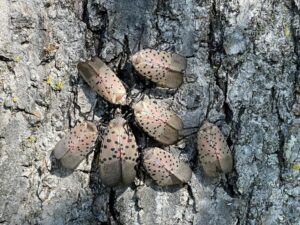
Right now, Maryland families have an important role to play in controlling the population of the Red Spotted Lanternfly (SLF)—destroying their egg masses and reporting sightings.
The striking insects have made headlines since they first arrived in the United States with their growing population, damage to crops and backyard infestations. But right now, there’s something everyone can be doing to help control their population: finding and destroying their camouflaged egg masses.
Finding the Egg Masses

SLFs begin laying their eggs in September and keep laying until the first frost, usually in November. The egg masses can be tricky to spot, so look at this photo of egg masses on a Silver Maple and share the photo with your family and friends to learn what to look for.
When they are first laid, they may appear gray in color. Once the waxy gray coating dries, the egg masses look like spats of mud. Each one of these egg masses contains more than 30 eggs.
The Maryland Department of Agriculture (MDA) lists the following trees as some of the host plants the SLF is commonly found to feed on: tree-of-heaven, grape, black walnut, red maple, silver maple, weeping willow and black willow. If your family has one of these trees on or near your property, this is the time of year to examine them closely for egg masses.
Families should also check outdoor furniture, lawn equipment, decks, fences or cars for egg masses. On trees, egg masses are typically laid on the underside of branches. Because the egg masses can be laid on such a variety of surfaces, dividing and conquering may be the best strategy for finding them. Parents can look up high while kids can search at their height.
Parents can add an element of fun to this important activity by encouraging kids to keep track of how many they find and offering a prize to whoever finds the most. The prize could be picking where to go for dinner or what movie to watch next.
“The priority for the insects is to provide protection for the eggs for the entirety of winter, so flat surfaces that have cover are highly likely to be laid on if they are near a large population of spotted lanternfly,” says Alexandra Benedik, an agricultural inspector for the MDA’s Spotted Lanternfly program.
How to Destroy the Eggs
If your family finds an egg mass, it’s important to crush and scrape it to lower the population size before next season.
“Any item can be used to do so, be it a credit card, a key or even a stick,” Benedik says. “Our program uses extendable painting poles with scrapers attached to crush and scrape egg masses that are high out of reach.”
Make sure the eggs are destroyed by pressing straight onto the egg mass until a crunch is heard. Scraping the eggs off is not enough, because the eggs could still survive on the ground.
Remember to Report
While Benedik notes that there are some areas in Maryland that have had high populations of SLF for some time, she still asks that people take a picture and submit their findings to the MDA’s online reporting tool.
Submitting your family’s findings helps the Maryland Department of Agriculture monitor population sizes and track the spread of the insect.
“It is important that we know if populations are increasing or decreasing and to know where that ‘edge’ is to better focus our efforts and lower the chance of spread,” Benedik says. “Simply seeing a spotted lanternfly is enough to warrant a report.”




